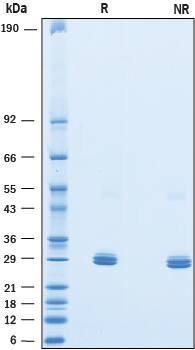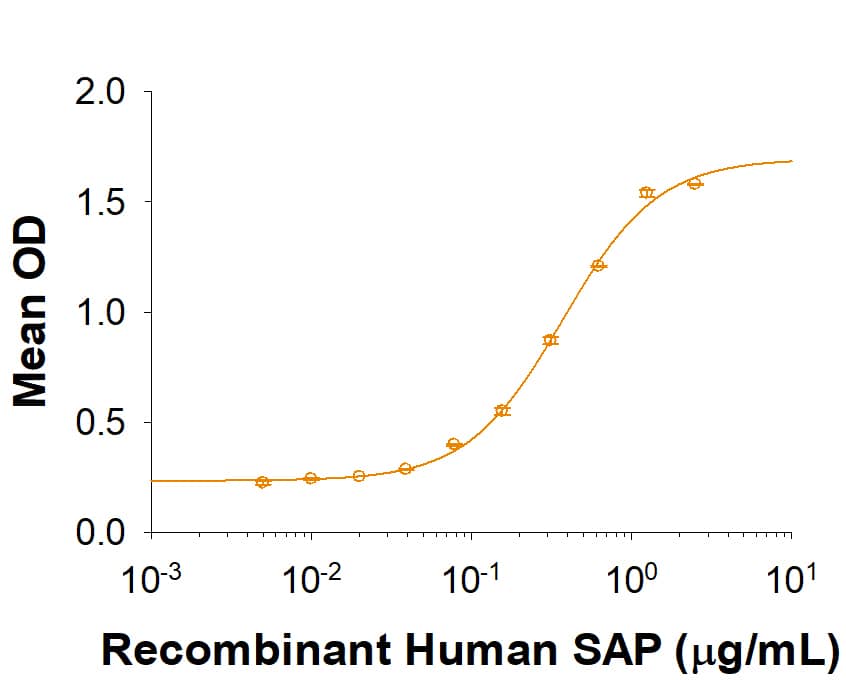Recombinant Human Pentraxin 2/SAP His-tag Protein, CF
R&D Systems, part of Bio-Techne | Catalog # 1948-SAB

Key Product Details
Source
Accession #
Structure / Form
Conjugate
Applications
Product Specifications
Source
His20-Val223, with a C-terminal 10-His tag
Purity
Endotoxin Level
N-terminal Sequence Analysis
Predicted Molecular Mass
SDS-PAGE
Activity
When Recombinant Human Fc gamma RllA/CD32a (R167) (Catalog # 1330-CD) is immobilized at 2 µg/mL (100 µL/well), the concentration of Recombinant Human Pentraxin 2/SAP that produces 50% of the optimal binding response is 0.175-1 μg/mL.
Scientific Data Images for Recombinant Human Pentraxin 2/SAP His-tag Protein, CF
Recombinant Human Pentraxin 2/SAP His-tag Protein Binding Activity
When Recombinant Human Fc gamma RIIA/CD32a (R167) (Catalog # 1330-CD) is immobilized at 2 µg/mL, 100 µL/well, Recombinant Human SAP binds with an ED50 of 0.175-1 µg/mL.Recombinant Human Pentraxin 2/SAP His-tag Protein SDS-PAGE
2 μg/lane of Recombinant Human Pentraxin 2/SAP was resolved with SDS-PAGE under reducing (R) and non-reducing (NR) conditions and visualized by Coomassie® Blue staining, showing bands at 27-33 kDa.Formulation, Preparation and Storage
1948-SAB
| Formulation | Lyophilized from a 0.2 μm filtered solution in MOPS, NaCl and CaCl2 with Trehalose. |
| Reconstitution | Reconstitute at 250 μg/mL in water. |
| Shipping | The product is shipped with polar packs. Upon receipt, store it immediately at the temperature recommended below. |
| Stability & Storage | Use a manual defrost freezer and avoid repeated freeze-thaw cycles.
|
Background: Pentraxin 2/SAP
Pentraxin 2 (PTX2), also known as Serum Amyoid P Component (SAP), is a secreted serum glycoprotein that is a universal non-fibrillar component of amyloid deposits. These extracellular deposits of insoluble protein fibrils are the result of protein misfolding and can lead to tissue damage and disease (1, 2). PTX2 belongs to the pentaxin superfamily, whose members have the characteristic pentagonal discoid arrangement of five non-covalently bound subunits. Pentaxins bind to a variety of molecules in a calcium-dependent lectin-like manner through a pattern-recognition-binding site (1, 4, 5). Two subfamilies of pentaxins, the classical or short pentaxin subfamily that includes the serum C-reactive protein (CRP) and PTX2, and the fusion or long pentaxin subfamily whose members contain pentaxin-related
carboxyl-terminal halves, are known (1).
PTX2 and CRP share approximately 50% amino acid sequence identity (2, 5). They are produced and secreted by liver hepatocytes and circulates in plasma. Mouse PTX2 is a major acute-phase protein whose plasma concentrations increase dramatically during an acute phase response (2). In human where CRP is the major
acute-phase protein, the plasma concentration of human PTX2 remains relatively constant in response to tissue-damage (2, 5). The gene for PTX2 has been localized to human chromosome 1 where it is closely linked to the gene for CRP.
PTX2 associates ubiquitously with all amyloid deposits that are implicated in a diverse range of diseases including Alzheimer’s and prion diseases, type 2 diabetes and various systemic amyloidoses (3, 6, 7). As a non-fibrillar component, PTX2 regulates the solubility of amyloid fibrils and protects them from degradation by proteolytic enzymes and phagocytic cells. In addition to its role in the pathogenesis of amyloidoses, PTX2 also has an important physiological function in innate immunity (8). It is an opsonin that interacts with all three types of human Fc gamma receptors that mediate phagocytosis by human polymorphonuclear leukocytes. It has been proposed that PTX2 may function as an opsonin for a variety of ligands including autoantigens, apoptotic cells, chromatin, DNA, and micro-organisms.
References
- Goodman, A. et al. (1996) Cytokine Growth Factor Rev. 7:191.
- Steel, D. and A. Whitehead (1994) Immunol. Today 15:81.
- Hirschfield, G.M. and P.N. Hawkins (2003) Int. J. Biochem. Cell Biol. 35:1608.
- Emsley, J. et al. (1994) Nature 367:338.
- Mantzouranis, E. et al. (1985) J. Biol. Chem. 260:7752.
- Botto, M. et al. (1997) Nature Medicine 3:855.
- Pepys, M. et al. (2002) Nature 417:254.
- Bharadwaj, D. et al. (2001) J. Immunol. 166:6735.
Long Name
Alternate Names
Gene Symbol
UniProt
Additional Pentraxin 2/SAP Products
Product Documents for Recombinant Human Pentraxin 2/SAP His-tag Protein, CF
Product Specific Notices for Recombinant Human Pentraxin 2/SAP His-tag Protein, CF
For research use only

